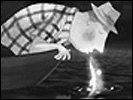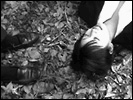- Document type
- Round-up
- Published
- 21 September 2005
Midnight Eye Round-Up
The 27th Pia Film Festival and the Cineastes Organization Osaka EX
By Jason Gray and Jasper Sharp
27th Pia Film Festival
Returning to Shibuya after 18 years, Pia Film Festival continues to be the light at the end of the tunnel for young filmmakers across Japan. Approaching a run of three decades, PFF truly remains a Japanese film festival for Japanese audiences (only one title, Mitsuru Meike's pink film, The Glamorous Life of Sachiko Hanai, a retitled version of last year's Horny Home Tutor: Teacher's Love Juice, had English subtitles, though the program book is at least fully bilingual). Each year the festival begins in Tokyo, then travels onto other cities including Nagoya, Osaka, Sendai, and Kita Kyushu. The PFF film scholarship (now in its 15th year) is awarded to one feature project per year, with the produced film premiering at PFF.
As is to be expected with indie cinema, the quality of this year's entries varied drastically. The features I saw were mostly decent, while many of the shorts were frankly terrible. It's hard to believe some of them were the best chosen out of almost 800 entries (every last one of which is listed in the back of the program - a nice gesture to the rejected entrants). This year's jury included Shinji Aoyama and Joe Odagiri.
- Arbelaez Humberto -into my life-
- BAMBI♥BONE
- A Fish With a Smile
- Water Flower
- The Sea of Thin Air
- Trojan Lust
Cineastes Organization Osaka EX (CO2)
- Red Restraint
- The Most Dangerous Man Alive!
- Ochon-chan: Pussy's Adventures in Love and Revolution
- Record of the Cry from the Deep Sea
- Red Seed
Arbelaez Humberto -into my life-
- Original Title:
- Arbelaez Humberto - Kieinu yo ni
- Director:
- Daisuke SEKI
- Cast:
- Humberto ARBELAEZ, Maya KATO, Tomomi KUBO, Tatiana SEI, Nobuko SEKI, Hiroshi TANIMOTO, Rika TANIMOTO
- Running time:
- 92 mins.
- Year:
- 2004
 The only documentary feature in this year's festival, Arbelaez... captures six years in the life of a Colombian man living in Japan as he struggles to find work and sort out his messy personal life.
The only documentary feature in this year's festival, Arbelaez... captures six years in the life of a Colombian man living in Japan as he struggles to find work and sort out his messy personal life.
The film starts off in 1998, with Humberto recounting the story of how he asked several people at the local tennis court if he could play with them, only to be refused until Daisuke (the film's director) and his friends welcomed him, thus beginning their relationship. Daisuke follows Humberto as he tries to find construction work to send funds to his large family back in Colombia. His visa is soon to expire and he's already working illegally, so Humberto ends up marrying long-suffering girlfriend Maya and is able to apply for a spousal visa. But because he has now overstayed, immigration penalizes him with a forced year out of the country. Right after Humberto arrives back in Columbia, there's news of a tragic earthquake - right in the area where Humberto lives. Unable to make any contact at first, Maya and everyone are relieved to hear Humberto and his family are okay. Keeping his word, he comes back to Japan and into Maya's arms.
The film jumps ahead three years, to 2003. Humberto is still struggling with his employment situation and his relationship with Maya is basically over, now having taken up with a younger woman named Tomomi. Humberto has a chance to become a seishain (a full-time company employee) at a construction company. While his spoken Japanese is good (he only speaks Japanese in the film) he can't read the employee agreement, so again he loses out. Tomomi becomes pregnant with Humberto's first child. He's overjoyed but the pressure is now on even more. By the end, things are looking up, but uncertainty hangs in the air.
Arbelaez... has value as a record of what many foreigners from poorer countries might go through in Japan. Mr. Arbelaez is basically a good-hearted person who wants to do the right thing, but the amazingly consistent trouble he gets in with his women and work becomes tiresome to watch. On the technical side, it's a no-budget, point-and-shoot affair, but Seki's documentary background gives him reasonable skill in selecting from what must have been mountains of footage. He also obviously gained the trust of his subjects to open up on camera. After the three-year break, the picture quality improves greatly - obviously because of a new camera purchase. It unintentionally bisects the film and gives the gauzy earlier footage a home movie feel and the present day scenes a reality TV look. The reocurring view from the director's window of a small agricultural patch being farmed by an elderly couple and going through the seasons seemed conspicuous - it's actually footage intended for a different documentary.
Arbelaez Humberto -into my life- went on to win the Grand Prix.
[JG]
BAMBI♥BONE
- Director:
- Noriko SHIBUTANI
- Cast:
- Shintaro TSUNODA, Marina NARUSHIMA, Kozo NISHIZAWA, Atsuko KOGANEZAWA, Sachiko OWAKI, Ayako AIDA, Michiro ENDO
- Running time:
- 78 mins.
- Year:
- 2004
 Hirokazu Koreeda's Nobody Knows seems to have spawned a sub-genre of films about troubled kids with even more messed up (or absent) parents. Noriko Shibutani's shot-on-video feature about a young boy and girl escaping the real world through play doesn't carry the emotional impact it'd like to, but there's enough to recommend.
Hirokazu Koreeda's Nobody Knows seems to have spawned a sub-genre of films about troubled kids with even more messed up (or absent) parents. Noriko Shibutani's shot-on-video feature about a young boy and girl escaping the real world through play doesn't carry the emotional impact it'd like to, but there's enough to recommend.
11 year-olds Tada and Aya have been friends since nursery school and wile away their days playing strange games together. Their favourite thing to do is to wear plastic bags with eye holes over their heads, running around the streets of Shishibone and spending hours going up and down the big slide at Tada's exclusive private school. When we see what their home lives are like, it's no wonder they (unintentionally) self-medicate through playing pretend. Aya often sits in the park across from her house as her mother's numerous male visitors come and go. Tada has to endure his father's total obsession with his legs, subjected to fervent fondling and having his toenails painted bright red. All the while, Tada's mother pretends the house is a happy home, but in the daytime walks around nicking flowerpots from around the neighbourhood. One day, the kids find a sheet of corrugated plastic and draw outlines of each others' bodies on it. Aya then stands behind it while Tada hurls mud and rocks. Tada's father spies on their rambunctious play, threatened by what's obviously a close friendship. That night, he ends up crawling into his own son's bed and raping him. When Aya comes over for dinner, Tada makes a scene and outs his father. Tada runs barefoot into the night, back to the junkyard where he sets the plastic representation of himself on fire in a rite of passage.
Instead of Nobody Knows' Suginami-ward, BAMBI♥BONE aspires to put non-descript Edogawa neighbourhood Shishibone (the English title is a literal translation of the kanji) on the map, but the film is unlikely to make it past the local bus stop. The theme of kids overcoming traumatic events is a noble one, but the thin narrative doesn't fully let us feel their plight. The quality of the videography is patchy, though there are some nice eye-popping colours and grainy but effective nighttime shooting. As with many video features, editing is a weak point. A lot of the sequences are repetitive and the reappearing "sweat sisters", an obese pair of women that hang around the area acting weird, is filler at best. Nonetheless, Tokyo-based filmmaker Shibutani (who worked under director Kazuo Hara) has a good rapport with child actors and plans to make another film based around kids. Quirky soundtrack provided by Mashcat (Emi Necozawa and Momus).
BAMBI♥BONE went on to win The Special Jury Prize and also received a Special Mention in the Dragons and Tigers Award section of the 24th Vancouver International Film Festival.
[JG]
A Fish With a Smile
- Original Title:
- Hohoemu Sakana
- Director:
- C. Jay SHIH, Alan TUAN, Poliang LIN
- Running time:
- 10 mins.
- Year:
- 2005
 The name "Jimmy" is apparently famous in Asia (including a large following in Japan) for his characters and picture books. Watching A Fish With a Smile, it's easy to see why. Hailing from Taiwan, Jimmy's books have been adapted into live-action films before such as Turn Left Turn Right (with Takeshi Kaneshiro), and Sound of Colors (with Tony Leung Chiu-wai) but this is his first animated collaboration.
The name "Jimmy" is apparently famous in Asia (including a large following in Japan) for his characters and picture books. Watching A Fish With a Smile, it's easy to see why. Hailing from Taiwan, Jimmy's books have been adapted into live-action films before such as Turn Left Turn Right (with Takeshi Kaneshiro), and Sound of Colors (with Tony Leung Chiu-wai) but this is his first animated collaboration.
A lonely looking man passes by a large pet shop aquarium where he spots an energetic little fish zipping around the tank. After a couple of visits, the fish smiles at him and the man can resist no longer - he buys the fish and brings it home. The pair live in domestic bliss, the perfect companions. One night, the man has a dream where the fish bowl floats out of the house with him in tow. They reach the ocean, where the man joins his friend underwater, swimming without a care in the world. Suddenly, the tables turn and the man finds himself in a glass orb being gawked at by the creatures of the ocean. He snaps out of his nightmare and makes a hard but necessary decision.
With not a word of dialogue, A Fish With a Smile is the saying "If you love something, set it free..." brought to life. The man and the fish are hand-drawn, water-colored 2D creations, while the lighting effects and world around them are rendered in softened 3D CG - they complement each other perfectly. Based on the charm and quality of this short, Jimmy and Taiwanese animation in general could become an international export and give the phrase "Made in Taiwan" a whole new meaning.
[JG]
Water Flower
- Original Title:
- Mizu no Hana
- Director:
- Yusuke KINOSHITA
- Cast:
- Saki TERASHIMA, Himawari ONO, Tetsushi TANAKA, Asuka KUROSAWA
- Running time:
- 92 mins.
- Year:
- 2005
 This year's deserving recipient of the PFF scholarship, which has helped produce such films as Ryosuke Hashiguchi's A Touch of Fever, Naoko Ogigami's Yoshino's Barber Shop, and Kenji Uchida's A Stranger of Mine, which was selected for last year's Cannes Film Festival Critics' Week. Water Flower is a sometimes affecting look at two young sisters who go on a journey together.
This year's deserving recipient of the PFF scholarship, which has helped produce such films as Ryosuke Hashiguchi's A Touch of Fever, Naoko Ogigami's Yoshino's Barber Shop, and Kenji Uchida's A Stranger of Mine, which was selected for last year's Cannes Film Festival Critics' Week. Water Flower is a sometimes affecting look at two young sisters who go on a journey together.
Minako (Saki Terashima) is a quiet junior high school student being raised by her overworked single father. She's at the age where he's more like an alien to her than a person. The situation is exacerbated when he comes home drunk one night and tries to climb on top of her. Minako's mother (A Snake of June's Asuka Kurosawa) deserted them for another man when Minako was a child. Now working as a hostess, she has little time for her own six year-old daughter, Yu (Himawari Ono), Minako's half sister. Both girls are yearning for their mother's love.
Minako runs into Yu at a game center in the mall and proposes they take a trip. She changes out of her school uniform and into adult clothes and the pair hop on an overnight bus out of the city, headed for their grandparents' home by the sea. It gets dark and both parents start to panic. They bump into each other at the police station, there to fill out missing person reports, and realize the girls are together.
Minako and Yu arrive in a little town and make their way to the old house. While en route, Yu sits on the end of dock playing next to the water. Minako creeps up behind her with the intent to push her in an unsettling moment (and apparently where the film's title comes from). She comes to her senses and the two arrive at the old family home and air it out. While playing a game of hide and seek, Yu finds an old photo album and sees her mom with Minako when she was a little girl. As their parents deal their culpability and unresolved issues back in the city, Minako is slowly able to forgive her mother through her time with Yu.
Kinoshita's film is quite assured for a 24 year-old, whose Birdcage won the PFF audience award two years prior. The screenplay is simple - setting up spaces for the actors to fill with emotion. Plot contrivances aside, there are some interesting role reversals, and a nice visual at the end. The 35mm cinematography is unflashy but carefully considered. The scene where little Yu does her ballet dance in the country home's front yard, even after it begins to pour rain, is both affecting and beautiful. A director like Kinoshita could easily be scouted to helm terebi dorama tearjerkers, but I'd hope to see him focus his talent in the feature film arena.
[JG]
The Sea of Thin Air
- Original Title:
- Sanketsu no Umi
- Director:
- Genta MATSUGAMI
- Cast:
- Naoki GOTO, Mika YAMADA, Akihiko YOSHIURA, Yui KATAOKA, Masahiro KURITA, Shintaro NAKANO
- Running time:
- 65 mins.
- Year:
- 2004
 The furiitaa subgenre is going to need its own section at the video shop soon, with chronicles of laziness such as Hazy Life, Tokyo Trash Baby, and of course Freeter being some of the more popular rentals. The Sea of Thin Air, yet another Osaka University of Arts graduation film given a festival airing, doesn't bring anything particularly new to the table but if dramas about aimless 20-somethings are your thing, there are worse ways to kill time.
The furiitaa subgenre is going to need its own section at the video shop soon, with chronicles of laziness such as Hazy Life, Tokyo Trash Baby, and of course Freeter being some of the more popular rentals. The Sea of Thin Air, yet another Osaka University of Arts graduation film given a festival airing, doesn't bring anything particularly new to the table but if dramas about aimless 20-somethings are your thing, there are worse ways to kill time.
Hayato (Naoki Goto) and Kazuya (Akihiko Yoshiura) are friends that "work" at a cardboard factory, shredding and sweeping all day while news of the ongoing war in Iraq streams from a portable radio. In their free time they hang out, play video games, go to the batting cage, and eat ramen. Kazuya has pipe dreams of going to America, but neither of them have ever been on an airplane. When payday comes, Kazuya quits citing boredom (naturally). After losing a bout of Playstation, Hayato treats Kazuya at the local whorehouse. There he meets a kind, pretty young prostitute (what other type is there?) named Satsuki, who clips his nails for him. Hayato becomes a regular customer, but he only wants to "talk". Soon after, Kazuya bumps into an old acquaintance (Yui Kataoka) and takes up drug dealing while Hayato soldiers on at the factory, training a string of part-timers who all eventually leave. Hayato and Satsuki become closer but Hayato is so passive that she finally has to demand he have sex with her. Things start looking up for Hayato, though Satsuki begins to see the dead-end she's in and quits working at the cat house. Meanwhile, Kazuya can't even make it as a playground pot purveyor and gets beaten up for his trouble, prompting him to sharpen up his wasted batting skills and take revenge. Satsuki clips Hayato's nails for the last time, packs her bags and hops on a train. Kazuya gets on a bicycle for parts unknown, and Hayato trains yet another new worker and asks him out for ramen.
Director Genta Matsugami, who's about the same age as his protagonists, had to turn to part-time work after the film's completion (and a lot of drinking). Fellow screenwriter Yoshitaka Kasui actually worked at the carboard factory featured in the film. The casting is spot-on, especially the po-faced Goto as Hayato. Kataoka is memorable as the loping, fur-coat wearing mary jane supplier. 16mm tech credits are fine, with the expected predominance of static shots to emphasize the inertia of the characters' lives. The little hooker hideaway provides a welcome splash of colour to the blue-collar palette. At 65 minutes, the film could afford a few more scenes to deepen the story, but true to a furiitaa's nature, any longer and things would get boring.
[JG]
Trojan Lust
- Original Title:
- Troy no Yokujo
- Director:
- Daichi OKA
- Cast:
- Hiroki MATSUI, Maria NAKAMURA, Tsuyoshi TAKASHIRO, Naoko ICHIKAWA, Katsuhiko KAWAMOTO, Kumiko OKA
- Running time:
- 85 mins.
- Year:
- 2003
 This 16mm graduation feature adds one more film cannister to the impressive and growing archives of the Osaka independent scene. Partially based on director Daichi Oka's own experiences, Trojan Lust sees a boy transform into a man, all without losing his virginity (not by the traditional definition, at least).
This 16mm graduation feature adds one more film cannister to the impressive and growing archives of the Osaka independent scene. Partially based on director Daichi Oka's own experiences, Trojan Lust sees a boy transform into a man, all without losing his virginity (not by the traditional definition, at least).
Teeming with hormones and criminally shy, highschool student Tatsuya (Hiroki Matsui) works part-time at a little pet shop. His schoolmate and co-worker, Motoko, shows interest but Tatsuya's unable to respond in kind - he's more interested in the anal masturbation device he buys himself for his 16th birthday. One night at a nearby vending machine, Tatsuya meets 20-something Miuko (Maria Nakamura) and buys her a drink. Their almost wordless exchange buzzes with a weird energy. The next day, she shows up at the pet shop and the pair bury a rabbit that has died, and so begins their strange relationship. Miuko is in an unsatisfying marriage with her architect husband and it soon becomes clear that she's had dalliances with teenaged boys before. Meanwhile, Motoko tires of Tatsuya's unresponsiveness and ends up with the pet shop's fat, éclair-gobbling owner. After a domestic spat, Miuko takes the car and picks up Tatsuya. She teaches him to drive, further spurring him to "be the man". Day becomes night and their joyride turns into a slightly sinister road trip with no clear destination in mind. They end up at an abandoned shack in the woods and Tatsuya quickly loses whatever dependance he had on his sex toy. Miuko's cuckolded hubby manages to track them down and even gives Tatsuya a ride back. This seems to threaten Tatsuya's newfound manhood and the situation boils over. Some time later, Tatsuya turns up at the couple's designer townhouse and re-asserts his will, but in the final scene Miuko turns the tables and shows him who's boss after all (in a moment that had usually quiet Japanese audiences gasping and/or laughing).
For a first feature, the air of eroticism is palpable and maturely handled, with basically no nudity to speak of. Lead actor Hiroki Matsui, a shy non-actor friend of the director from university, has the tough job of internalizing the things that happen to him (and that he does to himself), gradually leaving the boy behind. Maria Nakamura is effective as the would-be femme fatale. With her long, straight hair and sometimes bizarre behaviour, she comes off a bit like Tatsuya's own personal Sadako. Director Daichi Oka has some strange ideas and could be one to watch.
Trojan Lust went on to win 2nd Prize, Best Music, and Technical Prize.
[JG]
Red Restraint
- Original title:
- Akai Sokubaku
- Director:
- Masaki KARATSU
- Cast:
- Naoki GOTO, Yuka HIRAHARA , Kengo KANAMOTO, Hiroshi SHIMADA, Issei FUKUMORI
- Running time:
- 74 mins.
- Year:
- 2004
 Acting is an area in which mainstream Japanese movies so often open themselves up to criticism. It is a particular joy, then, to stumble across such enthralling performances as the ones showcased in this standout example of the kind of works that occasionally emerge from the field of jishu eiga - self-produced, do-it-yourself projects by budding filmmakers with little other training ground for their talents.
Acting is an area in which mainstream Japanese movies so often open themselves up to criticism. It is a particular joy, then, to stumble across such enthralling performances as the ones showcased in this standout example of the kind of works that occasionally emerge from the field of jishu eiga - self-produced, do-it-yourself projects by budding filmmakers with little other training ground for their talents.
A short feature shot on video and first exhibited at the Cineastes Organisation Osaka EX (or CO2) festival held by Planet Studyo + 1 and the city of Osaka, with only an amateur cast and little in the way of budget to work with, director Karatsu admirably plays to his strengths. Rather than overstretching himself with slick visuals and technical experimentation, he focuses on character and narrative.
Karatsu is lucky to have such a magnetic lead as Goto in front of the camera, playing the role of Arai. An incorrigible schmoozer, Arai works as a freelance web-designer, his work and his private life all but indivisible to the outsider as he flits between clients and his numerous girlfriends, all of whom remain blissfully unaware of one another. Graced with an almost overbearing charm and good humour, Arai is a hit with everyone in his social circles, but his true intentions remain unfathomable behind his impervious smile.
Then fate brings him into the lives of Kenji and Shoko, a newly married couple whose highly conservative lifestyle, consisting of work and washing-up rotas and the occasional night out in the baseball batting cage, is the very opposite of Arai's. Shoko immediately warms to Arai as he beguiles his way into their workaday lives, but Kenji remains suspicious of his motives, even after his wife encourages him to spend more time with their charismatic new friend. When Kenji begins to suffer from chronic short-term memory loss however, the balance in relationships between the three begins to shift.
While it is easy to single out Goto for special attention due to his larger-than-life yet wholly believable onscreen creation, the drama wouldn't work without Hirahara's subtle portrayal of Shoko, the newlywed whose loyalties find themselves severely divided, and indeed all of the cast work well off one another. Video-shot works such as these often find themselves overlooked, yet simultaneously engaging, tender and achingly funny, Red Restraint is a highly compelling drama that will keep the viewer riveted from scene to scene. Karatsu certainly looks like a director to watch for in the future.
[JS]
The Most Dangerous Man Alive!
- Original title:
- Sono Otoko, Kyobo ni Tsuki
- Director:
- Nobuhiro YAMASHITA
- Cast:
- Takashi YAMAMOTO, Yoko SATOMI, Nobuhiro YAMASHITA
- Running time:
- 49 mins.
- Year:
- 2003
With mainstream features such as No One's Ark and Ramblers behind him, you'd hardly have thought it necessary for Yamashita to go back and make a zero-budget 49-minute-long DV work for Kunihiko Tomioka, the producer responsible for launching his career. But watching The Most Dangerous Man Alive!, whose Japanese title is an innuendo-laden variation on that of Kitano's Violent Cop, it's soon clear why. Evidently everyone in the cast and crew had a huge amount of fun making this mockumentary about a corrupt plain-clothes policeman who moonlights as a "gravy actor" - a stunt double for the cum-shots in hardcore AV movies. Whether audiences will find it all so amusing is another matter.
Yamamoto, one half of the comic duo who made the Yamashita films Hazy Life and Ramblers so memorable is the "dangerous man" of the title, introduced via a series of talking head interviews conducted by the director in the run-up to his first "honban" hardcore sex performance. As he is paired together with his onscreen partner (played by Yoko Satomi, a real-life AV/pink actress who also counts minor roles in Makoto Shinozaki's Asakusa Kid and Teruo Ishii's Japanese Hell / Jigoku among her more mainstream appearances) prior to the shoot in order to get more comfortable together, a bout of nerves hints that the outcome of the shoot could well be in doubt.
The Most Dangerous Man Alive is essentially a one-joke movie. Unfortunately, unlike his other appearances in Yamashita's films, with no other strong characters to play against Yamamoto is allowed to ride rough-shod all over the film. Audience acceptance hinges on whether you find this awkward and quite OTT performance excruciatingly funny or just plain annoying. Chances are, it will probably be the latter, which is a shame, because, simply shot and with no real plot as such, there's little else here to focus one's attention.
[JS]
Ochon-chan: Pussy's Adventures in Love and Revolution
- Original title:
- Ochon-chan no Ai to Boken to Kakumei
- Director:
- Hiroshi NISHIO
- Cast:
- Yoko UEDA, Wataru KAWAGUCHI, Chiemi MINAMIYAMA
- Running time:
- 65 mins.
- Year:
- 2004
 Surreal, experimental tale in which Hana (Ueda), a sexually traumatized young girl, is advised by her doctor to write letters to her nether regions in order to re-forge a stronger connection between her heart and loins. Soon, at the factory producing rape alarms where she works, she meets Takeo, a disturbed young man who believes he is an alien and is plotting revolution against the human race.
Surreal, experimental tale in which Hana (Ueda), a sexually traumatized young girl, is advised by her doctor to write letters to her nether regions in order to re-forge a stronger connection between her heart and loins. Soon, at the factory producing rape alarms where she works, she meets Takeo, a disturbed young man who believes he is an alien and is plotting revolution against the human race.
Book-ended by a bizarre animated collage that juxtaposes blatantly sexual imagery like discarded underwear and a vertical pair of talking lips with childhood toys such as Victorian dolls and Humpty Dumpty, Ochon-chan follows a refreshingly unpredictable path, especially in its final third, where it leaps from scene to scene with little indication as to where it is going. This seemingly capricious development of its narrative can hardly be taken as a weakness in a film of this nature, but plays to one of the strengths of jishu eiga to produce a quirky image-driven tale of the type never seen in mainstream filmmaking. Full of striking images, Nishio's film benefits from an especially solid performance from its lead Ueda.
[JS]
Record of the Cry from the Deep Sea
- Original title:
- Shingai kara Sakebi no Kiroku
- Director:
- Masafumi YAMADA
- Cast:
- Toshiaki HOSOKAWA, Yusuke Maeda, Naoki MACHIHATA
- Running time:
- 19 mins.
- Year:
- 2003
 Yamada's stark, atmospheric document of the gory goings on in a processing plant for tuna fish is like a nightmarish vision of hell on earth, staged in an anonymous suburban hinterland and relayed in hyperrealistic green-tinged, juddering images accompanied by the disconcerting rattle and hum of Masumi Tokuami's minimalist soundscape. Anonymous human figures swathed in coveralls are relegated to the background as they saw through the giant fish carcasses or drag them across the floor with giant hooks, as if mere cogs in a machine, while Yamada's camera dwells on the non-narrative details of the cavernous space of this warehouse death camp. A discarded fish-head, of human size, gazes from the screen with blank accusing eyes, forcing the viewer to contemplate the dehumanised, sanitised process by which these majestic living creatures are transported from the depths of their natural element to meet their destiny as neatly-packaged morsels on a sashimi plate.
Yamada's stark, atmospheric document of the gory goings on in a processing plant for tuna fish is like a nightmarish vision of hell on earth, staged in an anonymous suburban hinterland and relayed in hyperrealistic green-tinged, juddering images accompanied by the disconcerting rattle and hum of Masumi Tokuami's minimalist soundscape. Anonymous human figures swathed in coveralls are relegated to the background as they saw through the giant fish carcasses or drag them across the floor with giant hooks, as if mere cogs in a machine, while Yamada's camera dwells on the non-narrative details of the cavernous space of this warehouse death camp. A discarded fish-head, of human size, gazes from the screen with blank accusing eyes, forcing the viewer to contemplate the dehumanised, sanitised process by which these majestic living creatures are transported from the depths of their natural element to meet their destiny as neatly-packaged morsels on a sashimi plate.
[JS]
Red Seed
- Original Title:
- Aka o Miru
- Director:
- Makoto ASAKAWA
- Cast:
- Mai MIZOGUCHI, Mami KISHIMOTO
- Running time:
- 38 mins.
- Year:
- 2004
 A poetic look at the life of a high school girl, Haruka, after the elder sister whom she adores commits suicide, this short work is more driven by its characters than its plot as Hana begins to awaken to her life after the tragedy through her friendship with classmate Eri.
A poetic look at the life of a high school girl, Haruka, after the elder sister whom she adores commits suicide, this short work is more driven by its characters than its plot as Hana begins to awaken to her life after the tragedy through her friendship with classmate Eri.
Unusually for an independent filmmaker nowadays, director Asakawa opts for the monochrome 16mm format, due to the requirement from sponsors Kodak that at least one of the films screened at Osaka's Cinetribe festival is shot on actual film. At a time when rookie filmmakers can so readily pick up a DV camera to make films, as if they were infants picking up a crayon to write their first novels, it is especially worth drawing attention to the work of the film's DP Ryuto Kondo, who conjures up some gorgeous images of Haruka and Eri's immediate environment around their school and homes. The highly professional, gorgeous end results working in perfect tandem with the material, demonstrate that the future of Japanese film is indeed in safe hands. Director Asakawa has a truly cinematic eye, and it will be interesting to see what he can do in a feature-length format.
[JS]